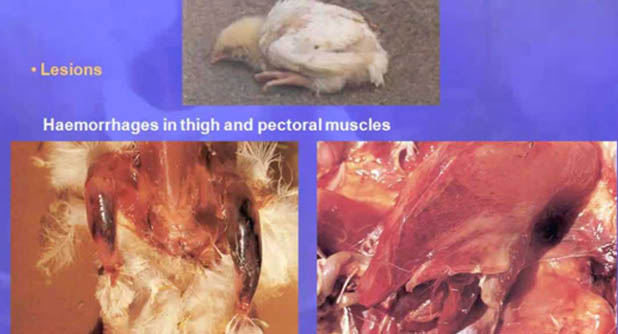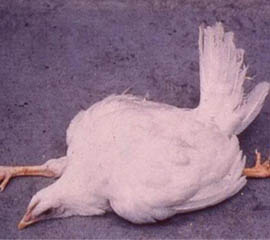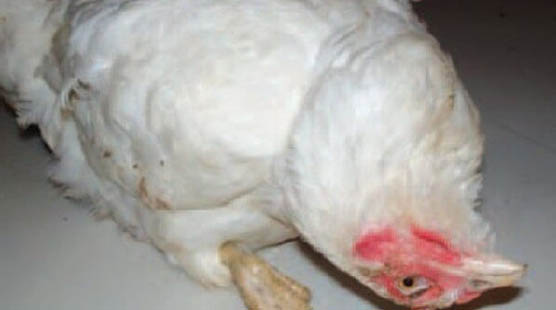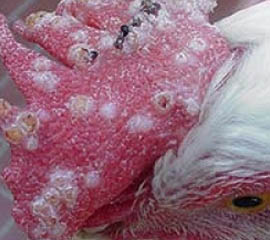 |
||||||||||||||||||
|
||||||||||||||||||
| VIRAL DISEASES | ||||||||||||||||||
| Back | ||||||||||||||||||
|
Infectious Bronchitis (IB): Cause: IB Virus is a member of coronaviridae family and is a single stranded RNA virus. Susceptible hosts: Chicken is naturally susceptible; IBV has also been isolated from pheasants causing respiratory signs and low egg production. Transmission: It is a very contagious type of infection. The infected birds develop clinical signs within 48 hours. Nasal discharge containing virus particles spread through aerosols, contaminated feed and water and the clothes of the visitors in the farm add to the transmission of the virus. Clinical signs: Signs in chicks: gasping and distressed breathing, beaks are open and distended upwards, eyes remain wet, mortality from 25-60%, tracheal rales, sneezing and hoarse cough present. Signs in growers:intensity of manifestation is less in this age group. The respiratory noise can be distinctly heard at night. Nephritic form of disease generally affects these birds. Wet droppings and increased drinking is seen along with urolithiasis. Lesions Upper respiratory tract shows signs of serous, catarrhal and fibrinous inflammation. The air sacs are cloudy and contain yellow exudate. In nephritic form, there is deposition of urates in the ureters and kidneys are pale. The oviduct shows metastatic changes and glandular dilatation. Treatment: No specific treatment is there. Provision of sufficient heat and decreasing the density of birds in the shed may help to decrease the clinical signs. Prevention and control: Through managemental procedures like disinfection of the poultry house, providing ample heat to the birds, avoiding overcrowding, raising different age groups of birds differently. Vaccination: Avian IB Vaccine freeze dried: 1 drop in each eye or nostril at 21 days of age, repeat booster at 6th and 14th weeks in drinking water. Avian Influenza: Synonyms: Fowl Plague. Susceptible hosts: Chickens, ducks, quails, pheasants and turkeys mainly. Cause: Avian Influenza Virus of family Orthomyxoviridae. It is an RNA virus having haemagglutinin and neuraminidase activity. Transmission: Main route is feco-oral route through contaminated fee and water. Bird to bird transmission through aerosol or droplet infection is present. Contaminated equipments and mechanical transmission by ants has also been reported. Clinical Findings: In per-acute cases, birds without showing any signs. Clinically there is decreased feed consumption, emaciation, severe respiratory signs like sneezing, coughing, moist rales, lacrimation, edema of head and face, cyanosis of featherless parts, cutaneous hemorrhage, nervous disorders and even diarrhea. Lesions: Hemorrhagic lesions in skin, liver, spleen, myocardium, heart, kidneys and lungs. Mild sinusitis and air sacculitis may be seen. Egg peritonitis may be found. Yellowish grey necrotic foci are seen in lungs, liver, spleen and pancreas. Spleen may be double in size. Crop is filled with watery fluid and gizzard is filled with greenish fluid. Treatment: Practically no treatment is present but studies had shown that Amantadine and Rimantadine in drinking water can reduce the mortality. Prevention and control: All the affected birds should be disposed off during an outbreak. Premises should be disinfected properly. No commercial vaccine is available although oil based emulsion vaccine can help. Strict hygienic measures need to be adopted during outbreak.
Infectious Bursal Disease (IBD): Synonyms: Gumboro Disease. Cause: Cause by double stranded RNA virus belonging to Birnaviridae family. Susceptible hosts: Both broilers and layers 2-9 weeks of age are most susceptible. Guinea fowls, quails and pigeons are resistant to natural infection. Transmission: Virus is discharged in feces and spread from one poultry shed to other by fomites. Direct transmission is present. The virus may remain alive in litter material for about 6 months. Clinical signs: Subclinical infections: birds remain dull and depressed and these infections are less obvious. Morbidity is more and mortality is less. Clinical form:birds show severe depression, watery diarrhea, in coordination, soiled vent feathers, vent picking and cloacitis Lesions Primarily lesions are present in Bursa of Fabricius. The bursa is swollen, edematous and yellowish. There is atrophy of bursa and the recovered birds have very small bursa due its degeneration. Pin point hemorrhages may be present in bursa. Congestion and hemorrhage is seen in pectoral muscles, thigh muscles, leg muscles and there is patchy hemorrhage at the junction of gizzard and proventriculus. Fatty changes in liver and urate deposition in kidneys are also seen. Treatment: No effective treatment present, however treatment can be given for changes in liver and kidney. Prevention and control: Strict hygienic and sanitary measure to be adopted. Visitors should be discouraged to enter the farm. Layers and broilers should be reared in separate cages. All dead birds should be disposed by burning. Vaccination:
Marek's Disease (MD): Cause: The disease is caused by a cell-associated herpesvirus (double-stranded DNA virus, hexagonal enveloped virus 150-160 nm diameter). Transmission: Infectious virus is produced only in feather follicle epithelium and spreads by direct or indirect contact between birds. Contaminated dust may remain infectious for several months. Darkling beetles may also act as a mechanical vector to carry the virus between houses. Clinical signs:
A presumptive diagnosis is made based on the presence of tumors and the observed paralysis; however, gross necropsy and histopathology are important to make a definitive diagnosis and to differentiate Marek’s disease from other forms of paralysis or recumbency (“knockdown”). Treatment: There is no specific treatment for chickens with Marek's disease. The emphasis is on prevention. Prevention: Vaccination against MD effective in controlling the disease. Marek’s disease vaccine is usually administered on day 1 or injected into the embryo three days prior to hatch. There are three types of vaccines commercially available: the HVT serotype 3, natural occurring avirulent isolates of serotype 2, and nononcongenic strains of serotype 1 (Rispens). MD vaccines often achieve over 90% protection under commercial conditions. The cell-associated HVT vaccine is widely used because it is more effective than the cell-free HVT virus in the presence of maternal antibodies. At least 1000-1500 plaque-forming units of virus are needed per dose.
Ranikhet Disease Synonyms: New Castle Disease, Avian Distemper, Doyle’s Diseases. Cause: Paramyxogroup-I virus. This is an RNA virus. This virus has got the property of haemagglutination. Susceptible Hosts: All species of poultry birds. Transmission: Chickens are affected by aerosols, infection may spread through feces, eggs and infected carcasses. Air borne transmission is most important means of transmission. The sneezing and coughing by infected birds lead to emission huge lots of virus. Clinical signs: In young birds: Respiratory and nervous signs, respiratory signs include coughing, sneezing, gasping, hoarse breathing. Birds excrete chalky feces. Nervous signs include clonic spasms, inco-ordination, lameness, tremors, opisthotonous. In adult birds: Watery diarrhoeic feces, color of feces may vary from from greenish to chalky, the change in color is due to release of excess bile and urates in the feces. Birds show hoarse bresthing and gasping. There is sharp decline in egg production. Eggs have soft shells and are watery. Nervous signs are not evident in adult birds. Gross Lesions Cellular infiltration and petechiation of the iris in eye, air sacculitis, pin-point hemorrhages in the apex of proventricular glands, hemorrhage ubder the horney layer of the gizzard, ulcerative and hemorrhagic lesions in the cecal tonsils, degenerative changes in the brain and spinal cord. Diagnosis: A presumptive diagnosis is made based on the presence of tumors and the observed paralysis; however, gross necropsy and histopathology are important to make a definitive diagnosis and to differentiate Marek’s disease from other forms of paralysis or recumbency (“knockdown”). Treatment: There is no effective treatment, only the broad spectrum antibiotics are given to prevent the secondary bacterial infection. Prevention: mainly relies on vaccination. Three types of vaccines are used: a. Lasota strain or F strain: 4-10 days old chicks: intraocular or nasal drop method 4-5 weeks: intraocular or drinking water as booster 15-16 weeks: drinking water as 2nd booster. b. R2B (Mukteshwar) strai:Breeding flocks at 8-10 weeks of age. Booster is given at 17 weeks age. Dose is 0.5 IM. c. NCD killed vaccine:Layer and broiler flock at 16-20 weeks age. Dose is 0.5ml subcutaneously or intramuscularly (IM).
Fowl pox:
Avian encephalomyelitis (AE) AE is a disease of poultry, turkeys, pheasants and quail, which affects only chicks from hatching to about two months of age. The symptoms are dullness, tremors of the head, staggering, paralysis and prostration. Adult birds show no symptoms other than a decline in egg production, but they carry the virus and pass it on through the egg. The disease may also spread from chick to chick and up to 60% of birds may be affected. There is no treatment for AE but vaccination will prevent it. |
||||||||||||||||||
|
|
||||||||||||||||||
| Back | ||||||||||||||||||
|
||||||||||||||||||
| Scroll | ||||||||||||||||||
| Division of Veterinary and Animal Husbandry Extension Education Faculty of Veterinary Sciences and Animal Husbandry, R.S. Pura, SKUAST Jammu | ||||||||||||||||||





